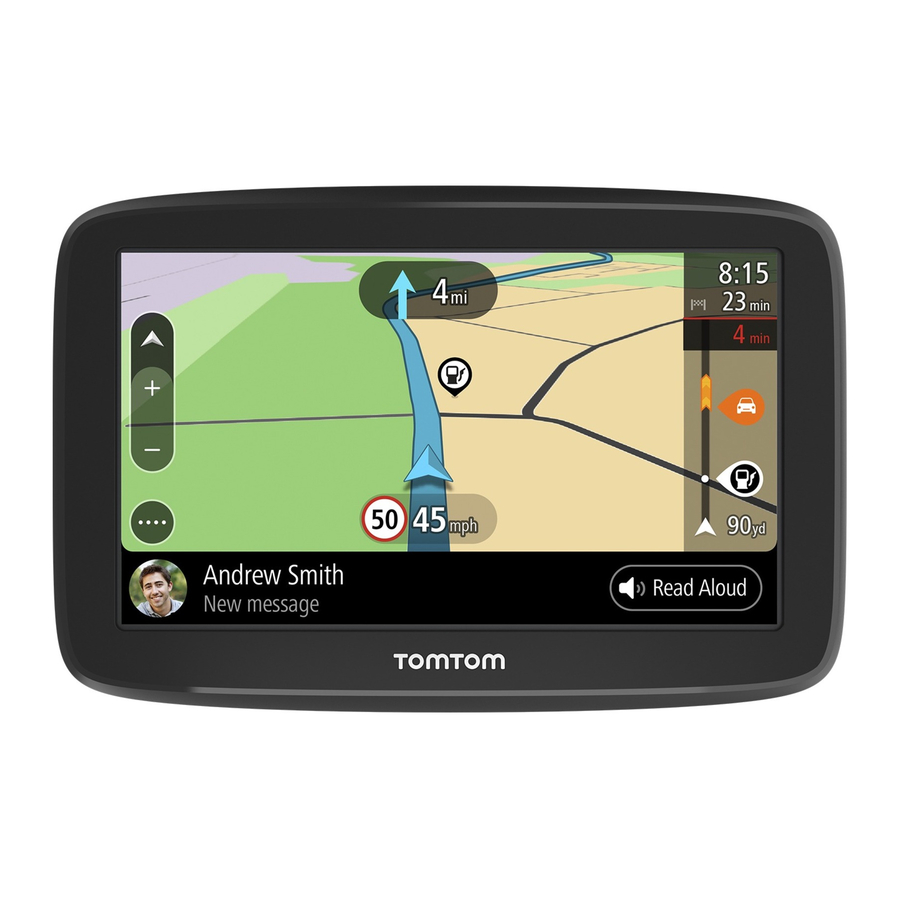cAddendum-US.fm Page 1 Wednesday, August 20, 2008 3:07 PM
Addendum
Important Safety Notices and Warnings
Adden-
dum
Global Positioning System
The Global Positioning System (GPS) is a satellite-based system
that provides location and timing information around the globe.
GPS is operated and controlled under the sole responsibility of the
Government of the United States of America, which is responsible
for its availability and accuracy. Any changes in GPS availability and
accuracy, or in environmental conditions, may impact the operation
of your TomTom device. TomTom does not accept any liability for
the availability and accuracy of GPS.
Use with Care
Use of a TomTom device for navigation still means that you need to
drive with due care and attention.
Aircraft and Hospitals
Use of devices with an antenna is prohibited on most aircraft, in
many hospitals and in many other locations. A TomTom device
must not be used in these environments.
Battery
This product uses a Lithium-Polymer battery. Do not use it in a
humid, wet and/or corrosive environment. Do not put, store or
leave your product in or near a heat source, in a high temperature
location, in strong direct sunlight, in a microwave oven or in a
pressurized container, and do not expose it to temperatures over
60 C (140 F). Failure to follow these guidelines may cause the
Lithium-Polymer battery to leak acid, become hot, explode or ignite
and cause injury and/or damage. Do not pierce, open or
disassemble the battery. If the battery leaks and you come into
contact with the leaked fluids, rinse thoroughly with water and seek
medical attention immediately. For safety reasons, and to prolong
the lifetime of the battery, charging will not occur at low (below 0 C/
32 F) or high (over 45 C/113 F) temperatures.
Temperatures: Standard operation: -10 C (14 F) to +55 C (131 F);
short period storage: -20 C (-4 F) to + 60 C (140 F); long period
storage: -20 C (-4 F) to +25 C (77 F).
THE LITHIUM-POLYMER BATTERY CONTAINED IN
THE PRODUCT MUST BE RECYCLED OR DISPOSED
OF PROPERLY. USE YOUR TomTom ONLY WITH
THE SUPPLIED DC POWER CABLE (CAR CHARGER/
BATTERY CABLE) AND AC ADAPTER (HOME
CHARGER) FOR BATTERY CHARGING.
To recycle your TomTom unit please see your local
approved TomTom service center.
SPECIAL NOTE REGARDING DRIVING IN CALIFORNIA AND MIN-
NESOTA
California Vehicle Code Section 26708 (a) (1) provides that "No
persons shall drive any motor vehicle with an object or material
placed, displayed, installed, affixed or applied upon the windshield
or side or rear windows." Drivers in California should not use a
suction mount on their windshield, side or rear windows.
Note: this section of the California Vehicle Code applies to anyone
driving in California, not just California residents.
Minnesota State Legislature Statutes Section 169.71, subdivision 1,
section 2 provides that "A person shall not drive or operate with any
objects suspended between the driver and the windshield other
than sun visors and rearview mirrors and electronic toll collection
devices."
Note: this Minnesota Stature applies to anyone driving in
Minnesota, not just Minnesota residents.
TomTom Inc. bears no responsibility for any fines, penalties or
damage that may be incurred by disregarding this notice. While
driving in any state with windshield mounting restrictions, TomTom
recommends the use of the supplied Adhesive Mounting Disk or its
Alternative Mounting Kit, which includes multiple options for
mounting TomTom devices on the dashboard and using the air
vents. See www.tomtom.com for more information about this
mounting option.
FCC Information for the User
This product contains a transmitter which must not
be co-located or simultaneously operated in
conjunction with any other transmitter.
Exposure to Radio Frequency Radiation
This device complies with FCC radiation exposure
limits set forth for an uncontrolled environment. In order to avoid
the possibility of exceeding the FCC radio frequency exposure
limits, human proximity to the antenna shall not be less than 8
inches (20 cm) during normal operation.
Radio and Television Interference
This equipment radiates radio frequency energy and if not used
properly - that is, in strict accordance with the instructions in this
manual - may cause interference to radio communications and
television reception.
This device has been tested and found to comply with the limits for
a Class B digital device, pursuant to Part 15 of the FCC Rules. These
limits are designed to provide reasonable protection against
harmful interference in a residential installation. This equipment
generates, uses and can radiate radio frequency energy and, if not
installed and used in accordance with the instructions, may cause
harmful interference to radio communications. However, there is no
guarantee that interference will not occur in a particular installation.
If this equipment does cause harmful interference to radio or
television reception, which can be determined by turning the
equipment off and on, the user is encouraged to try to correct the
interference by one or more of the following measures:
•
Reorient or relocate the receiving antenna.
•
Increase the separation distance between the equipment and
the receiver.
1

